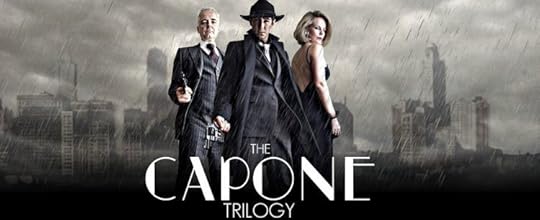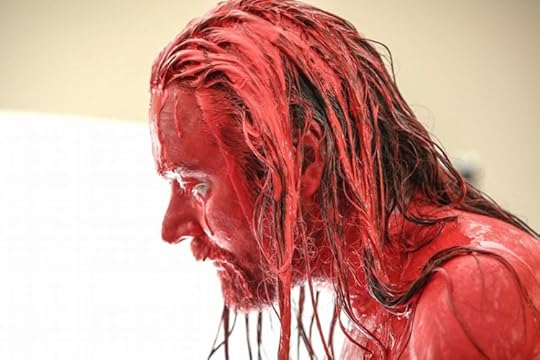Teodor Reljic's Blog, page 19
August 24, 2014
Crime & Punishment | Edinburgh Fringe 2014 Reviews – Part 1
Before I set off for my first-ever trip to the Edinburgh Fringe Festival, I laid out a couple of unassailable ground-rules for myself, namely:
1) No stand-up comedy. There did turn out to be an exception to this rule (more on that later, and trust me when I say that it truly was exceptional), but the fact is that the Fringe has become over-saturated with stand-up over the past few years (or so I hear from my kind hosts) and even if I wanted to delve into the comedy on show, it would take me a good couple of days to rifle through that particular section of the programme to isolate a few favourites. Which brings me to the next rule.
2) No running around like a headless chicken. Look, I know that a part of the Fringe’s appeal is that it’s a gathering of both the best and worst performing arts talent – that it’s supposed to be, in theory, a democratic free-for-all that both showcases tried-and-tested quality talent and provides a testing ground for up-and-comers. And though I understand the appeal of just wandering into – often free-of-charge – student productions and stand-up comedy shows by unknowns, I didn’t want to add that element of randomness to the hassle of finding my way around venues in a city I wouldn’t have been all that familiar with anyway.
Despite these restrictions, however, I still think I managed to pinpoint a selection of events that were both eclectic and very much worth my time. Here’s reviews for the first two – more to come!
AUGUST 1 – 14:00 – The Capone Trilogy: Loki
A blisteringly energetic comedy of errors that owes more to classic-era Hollywood than Norse mythology.
Jethro Compton Productions set themselves an admirable challenge: perform a six-play cycle at this year’s Fringe, all of which take characters from history, literature and mythology as a starting point and transpose them to a specific historical setting: World War I in the case of ‘The Bunker Trilogy’ (Morgana, Agamemnon and Macbeth) and, well, you-know-what in the case of ‘The Capone Trilogy’ (Loki, Lucifer and Vindici).
Being a fan of trickster myths in general and Norse mythology in particular, I decided to sample Loki out of this batch of intriguing-sounding and supposedly ‘immersive’ one-act plays.
Well as it turned out the mythological hook was just that – a convenient way of labeling what is essentially a rat-a-tat pastiche of classic-era Hollywood gangster films and imbuing it with some post-facto gravitas. To wit: the only real connection to the titular Norse trickster god is our protagonist’s name: Lola Keen (!), a showgirl keen to put herself on the straight and narrow path – an ambition we see unravel in front of our very eyes as Lola consistently fails to remain faithful to her dull and morally upright husband on the eve of their wedding night.
The extent to which the production is in fact ‘immersive’ is largely down to just the size of the venue itself. Studio 7 of the C-Nova is transformed into a cramped hotel room that soon develops an often abused and potentially dangerous revolving door policy. Preece remains an alluring and likable presence throughout – the beat-perfect slapstick that underpins the entire play leaves little room for wallowing in the casual cruelty of Lola’s behaviour, instead moving things along and making sure that the gags are coming in thick and fast.
Preece’s co-stars David Calvitto and Oliver Tilney deserve the lion’s share of the credit, however, as they effortlessly alternate between a myriad of characters which run the gamut from henpecked husbands, hot-blooded Italian suitors, the good/bad cop combo, submissive bellboys and clueless gangsters.
Written by Jamie Wilkes and directed by Jethro Compton, the play is neither formally groundbreaking nor emotionally resonant, but it commits so entirely to the source material that it’s paying homage to that it can’t help but be a raucously entreating hour from start to finish.
AUGUST 2 – 15:15 – The Lieutenant of Inishmore
A blood-splattered satire penned by Martin McDonagh (In Bruges, Seven Psychopaths) that does for IRA-inspired splinter groups what Four Lions did for hare-brained Muslim fundamentalists.
This In Yer Face Theatre production not only lives up to its company’s name with a vengeance – it also paved the way to a Fringe day marked by projectile fluids (more on that in the next post).
As someone who holds the likes of Quentin Tarantino, Clive Barker and Nicolas Winding Refn as cultural touchstones, the promise of being splattered in blood during a live theatre show was bound to capture my interest either way – good thing that IYF succeed in giving McDonagh’s brutally funny script a run for its money: the cast-and-crew clearly get that, despite the frequent jets of blood and gristly acts of violence that occur during the course of this short-and-sharp one act (both on and off stage), the play is first and foremost a goofy farce, albeit one with a politically-focused satirical backbone.
Self-styled ‘Lieutenant’ of IRA splinter-group INLA Padraic (Mark Barrett) takes a break from administering brutal justice to INLA infidels after he’s drawn back to his hometown of Inishmore. The reason? His beloved cat, Wee Thomas, is revealed by his drunken father Donny (Kenny MacLeod) to be doing “poorly”.
The fact that the poor cat is beyond any help is, hilariously, what propels this (literally) bloody mess of a play into action.
The (once again) minuscule performance space at the Hill Street Drama Lodge is made to look like Dexter’s ‘kill room’, with black plastic bags coating the room from floor to ceiling. That the audience (never topping the 15-seat mark) is given ponchos to guard from the jets of splatter that we’re promised is to come adds to the excitement.
But the play itself both plays into and transcends this initial gimmick. It’s a bloody play, yes, but this isn’t a scary fun-fair ride, it’s a knowing and urbane take-down of the ignorance that underpins fundamentalist, retribution politics.
Though a penchant for gore and black humour may be necessary to go along with the ride as gleefully as the play asks you to, the gory set pieces are more Looney Tunes than torture porn, and McDonagh partakes in a noble satirical tradition which uses humour to show how grisly but supposedly righteous acts of terror are often executed by clueless idiots operating on a murky-at-best understanding of ideology.
Next time: CHRISTEENE!


August 20, 2014
Fringe & Con | Edinburgh + London break

Visiting the Edinburgh Castle too touristy? FUCK YOU, IT’S A GODDAMN CASTLE.
I’ve taken a bit of a break from the blog over the past few weeks because I’ve taken a break from life in general.
To wit, I’m newly returned from a two-week trip to Edinburgh and London, as I embarked on a mission to escape from the Heat & Humidity combo that characterizes the Maltese Islands during this time of the year, while also taking in two major cultural events I’ve always wanted to check out but have never really had the opportunity to until now, namely the Edinburgh Fringe Festival and LonCon (aka WorldCon, aka the World Science Fiction Convention aka The Geek Convention That Clearly Suffers From An Identity Crisis).
Having these big events as bookends to the holiday was useful, because I’m a pretty shitty traveller, by all accounts.
I’m certainly not an experienced one: having been stifled by a Serbian passport for the longest time, I’ve only been freed to embark on the kind of heedless global traipsing a lot of my peers take for granted after I was finally granted a Maltese passport.
And that was only two years ago.
So I’m an inexpert and often flustered mad-reader, an inexpert and often nauseous train-traveller, and a persistent shyness (coupled with the fact that I’m socially spoiled by Malta’s insular and rapidly-mushrooming social circles) makes me hesitant to meet and mingle with locals unprompted.
But as luck would have it, I have friends in both Edinburgh and London who were – once again – more than willing to open their doors to me and let me crash at their respective abodes, which automatically calmed any Nerves of Displacement I may have had and allowed me to enjoy the stuffing out of my stay.
*
So I’ll be posting about some highlights from the trip in the coming days. Expect a few capsule reviews of Fringe Festival stuff I got to see, as well as some observations from LonCon.
Beyond these often wonderful ‘distractions’, you may catch hints of my total and complete love for Edinburgh: a gem of a city that somehow manages to be both cosy and cosmopolitan…

It’s also gorgeous at dusk.


July 27, 2014
Homing
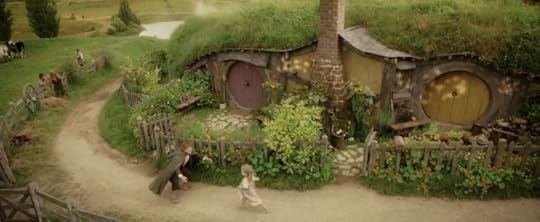
Samwise Gamgee returns to the Shire, in the final scene of Return of the King (2003)
“There is no safe place from the injuries of history; home as a place or a time of innocence can only be an illusion. But the poet doesn’t recover the bitter past to serve present grudges – his acts of remembering, his quest for identity are grounded in generosity.
“And from this sense of loss and recovery, this mix and merging, this reckoning with the complexities of the past, present national identity and patterns of belonging can be fruitfully formed. The way Walcott has worked the material of his complicated memories and inheritance in the Caribbean represents an exemplary openness to making a new model of the homeland, which doesn’t exclude, but rather includes, which doesn’t justify, but seeks to understand. No home is an island; no homegrown culture can thrive in permanent quarantine. We’re all wayfarers and we make our destinations as we go.” – Marina Warner
*
Read related: Virtual Borders, Virtual Wars


July 24, 2014
Virtual Borders, Virtual Wars | Dawn of the Planet of the Apes
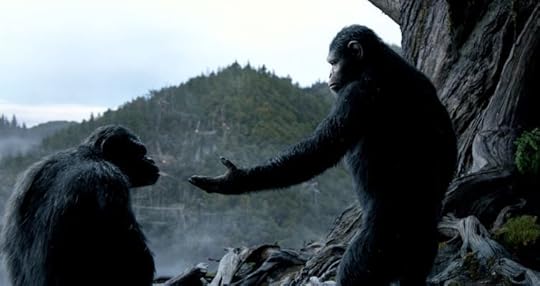
Toby Kebbell (left) as Koba and Andy Serkis as Caesar in Dawn of the Planet of the Apes
Watching Dawn of the Planet of the Apes – an entertaining and effectively realized action-blockbuster, by all accounts – reminded me of just how much the idea of home is related to complete, all-out aggression. It is one of the key justifications for war, and if it isn’t Hollywood blockbusters that remind us of it, real-life world events will, unfortunately, persist in doing their darndest to ensure that we do not forget.
From my sheltered and privileged standpoint, obsessing over national borders instinctively feels doubly surreal, as I – like many people of my generation, and many of those living in some kind of diaspora – have made the internet their second home. Cultivating and negotiating a virtual identity has become a direct part of who we are, and the more that shapes itself into the fabric of our day-to-day life, the more it will assume the likeness of an undeniable, self-evident and near-physical ‘space’ which we may feel justified in fighting over.
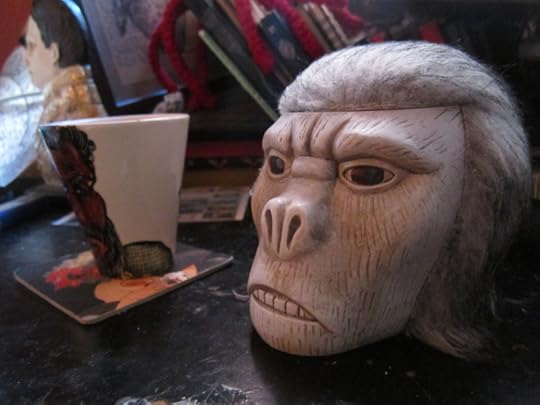
Even my workspace has apes in it
Beyond the fever dreams of cyberpunk – from William Gibson to The Matrix – the web has become so ‘normal’ that it’s not far-fetched to assume that it will soon adopt other, less pleasant features of human ‘normality’ – our insistence on waging border wars being just another one of them. The ongoing debate over net neutrality is one explicit portent of the above, but I’m sure there will be many related polemics to come.
*
Another thing that Dawn of the Planet of the Apes – or DOTPOTA, an acronym I love – brought to mind is the panicked and often messy way in which pop culture responds to contemporary anxieties, and processes ‘universal’ themes.
To my mind, the film is great because its ‘message’ doesn’t feel like a tacked-on imposition, but part and parcel of its conceit. Of course, Matt Reeves’ continuation of the Planet of the Apes mythology reboot doesn’t really say anything new about the enduring phenomenon of border conflicts, or our stewardship of the earth. But I’d still like to think that it contributes to the discussion in its own way.
Though even the word ‘discussion’ feels wrong here – it assumes a lilting, rational conversation about carefully ironed-out topics. Because what we in fact get is far more chaotic: the necessities of crafting a crowd-pleasing blockbuster in which talking apes do battle with economically compromised humans only allows lucid allegory to slip through up to a point.
The presence of Zero Dark Thirty actor is significant here.
Like DOTPOTA, Zero Dark Thirty is an action-intensive mainstream film shot with a gloomy palette that has become par for the course among blockbusters which aspire to court the critical consensus as well as the box office success that it is often assumed they would secure anyway.
(Largely blaming Christopher Nolan’s stratospherically successful Batman film The Dark Knight, critics of this pervasive aesthetic trend have taken to name-calling it ‘grimdark’.)
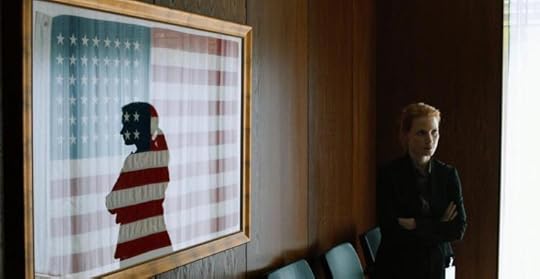
Jessica Chastain in Zero Dark Thirty
But unlike DOTPOTA, Zero Dark Thirty is about a very specific and very real event – a persistently controversial one, to boot. Katheryn Bigelow’s treatment of the steps taken to ensure the assassination of Osama Bin Laden is a fascinating watch even if you – like me – were unconvinced by its narrative thrust and troubled by its murky ethics.
Whichever way you slice it, ZDT was a brave attempt at tackling a very recent and morally, politically fraught scenario. In the end its internal contradictions forced it to devour itself, but only because Bigelow aspired to tackle her subject head-on, with as little aesthetic filters as possible.
This is where genre allegories like DOTPOTA have the upper hand. The way the message is processed is of course open to cynical interpretation: “It’s not really saying anything, they’re just re-treading secure narrative and thematic ground to ensure they make money at the box office”.
But the mere fact that it’s out there, doing its thing for a large audience who will enjoy it – or not – on the surface level to begin with feels like some kind of potential triumph.
*
Final question: as more of the world goes online, as more of the world does ideological battle online and as more of our personal identity is shaped and justified by our online presence, will the web be treated by poets much in the same way as the natural world has been treated in earlier times?


July 22, 2014
Exploding

The Last Day of Pompeii by Karl Briullov (1830-33)
“When there’s a big explosion, it doesn’t really have a visceral impact on the audience if it’s just flinging people through the air. They know that’s just stunts. But if you fly people through the air and they then they hit something, it’s a lot better. And then if they hit something really hard — like, you know, a brick wall — it’s even better. And if they hit a kind of rough edge on that brick wall, then you’re getting to the good stuff. And then if what they hit breaks, then that’s the best.” – Paul W.S. Anderson
*


July 15, 2014
Why I love NBC’s Hannibal – Part II

Not a spoiler: In a typically bold move, the first episode of the second season of NBC’s Hannibal opens with a far-reaching and action-packed flash-forward
It’s been a while since the second season of NBC’s Hannibal has wrapped up, I know – well, ‘a while’ in today’s always-constantly-updated online world anyway – but I had neither the time nor the inclination to pen this follow-up to my initial post straight away.
First off, it’s fun to just luxuriate in an intense, contentious season finale before commenting on it; to let the swathe of online commentary wash over you and even, perhaps, share in some of it.
Of course, those who have seen it will know what I’m talking about, and I doubt there’s a lukewarm opinion on how the blood-soaked and – though the final outcome remains teasingly to be seen – tragic final reel of what was a superb season of television plays out.
You either love the tortuous downward spiral (oh, but doesn’t it look so exquisite!) Bryan Fuller has put you through or you don’t, and this season in particular, I think, urges you to take a final decision on how you feel about the overall raison d’etre of this unapologetically baroque show.
Because while the first season had as its commercially-friendly ballast a ‘monster of the week’ structure – with the Will-and-Hannibal storyline unspooling in increments in the background – Fuller and co. have clearly been given carte blanche this time around.
*

Style over substance? Hannibal is unapologetically baroque
This is not a smoothly calculated show. It’s a show that grows and develops, contorting to fit its shape – sometimes its development is fractious and misjudged but it’s certainly moving towards something. The fact that it’s a prequel to an established book-and-film property already gives it a final end-point, but Fuller is also mining deeper into Thomas Harris’ Hannibal mythos in a way that feels both daring and appropriate.
I’ve mentioned the danger of overstretching a storyline beyond its limits in the previous post. But in taking the risk to ‘gild the lily’ of what was previously established by Harris and his cinematic forebears, Fuller actually ends up giving us something more; and yes, in this sense more is more because it builds convincingly on the beguiling psychological bind that the Hannibal stories are bound by.
*
With the right tools and the right brains at the wheel, the idea of a cannibalistic serial killer not only aiding a ‘consulting detective’ – let’s acknowledge the intertexual link between Will Graham and Sherlock Holmes, please – with the crimes he’s charged with, but also seeking a bona-fide relationship with him, is rich dramatic pickings whichever way you slice it (hur, hur).
A friend of mine pointed out how Fuller’s Hannibal is more of a Freudian creation, as opposed to the ‘Jungian’ archetype we see in the Harris novels and their accompanying film adaptations.
I tend to agree, not only because NBC-Hannibal is still a slippery figure in every sense of the word, as he’s not had a chance to solidify into the kind of antagonist-consultant role he occupies in the canon narratives. (Going by a sort-of Proppian definition of his archetypal role in the source material, could we perhaps say that he’s both central antagonist AND wise old man figure? Both Darth Vader and Obi Wan Kenobi?)
NBC-Hannibal is harder to define in those terms, but he is of course also the show’s organising principle and thematic core at the same time (note that he is not, however, the protagonist – that journey belongs to Will – even though the show is named after him).
*

In captivity, in therapy: Hugh Dancy as Will Graham
Here’s the crux of it all: this is a show about therapy; or, at least, it’s a show that takes the raison d’etre of therapy and applies it to a dimension none of us would have dared to venture, given the choice.
This isn’t just because Hannibal Lecter himself happens to be a therapist (and a good one at that). Having therapy as a conceit – and it’s a consistent one for the show – means that the show is about the unravelling of the self, about a constant attempt to cut through the confusion and dross of everyday consciousness to arrive at some deeply embedded truth about yourself.
This is of course evident in Will’s zig-zagging psychological journey across the show’s two seasons, but in a coup of form vs content that elevates the show to what feels like a bona fide – though almost accidental – work of art, it’s also matched in both the narrative structure and cinematographic landscape of its second season.
Whereas Hannibal’s diabolical mentoring of Will came in fragmented drops in Season One – due to the rat-a-tat rhythm of the one killer per episode structure – come the second season it gets a broad sweep, largely owing to Will’s uncomfortable – and highly vulnerable – predicament.
To be concluded


July 13, 2014
Khaning

Niccolò and Maffeo in Bukhara, where they stayed for three years. They were invited by an envoy of Hulagu (right) to travel east to visit Kublai Khan. (Source: Wikipedia)
“Opium was the avenging daemon or alastor of Coleridge’s life, his dark or fallen angel, his experiential acquaintance with Milton’s Satan. Opium was for him what wandering and moral tale-telling became for the Mariner – the personal shape of repetition compulsion. The lust for paradise in ‘Kubla Khan,’ Geraldine’s lust for Christabel – these are manifestations of Coleridge’s revisionary daemonization of Milton, these are Coleridge’s countersublime. Poetic genius, the genial spirit itself, Coleridge must see as daemonic when it is his own rather than when it is Milton’s.” – Harold Bloom
*


July 11, 2014
Monstrous Indulgences | Guillermo del Toro’s Cabinet of Curiosities
This volume may be the epitome of indulgence, and the tone of Marc Scott Zicree, Guillermo del Toro’s interviewer – and effective co-writer in this endeavour – can come across as a bit sycophantic at times.
But really, a ‘cabinet of curiosities’ can’t help but be a gloriously indulgent exercise, and you don’t come here to read a sober dissection of del Toro’s life and filmography.
No, you come here to luxuriate in what is probably the ultimate ‘behind the scenes’ look into Del Toro’s oeuvre, as presented in a gorgeous coffee table edition crammed with photographs and studded with mini-essays by Del Toro’s friends and collaborators (the book is framed by tributes from James Cameron and Tom Cruise, respectively).
The book introduces us to Del Toro’s eclectic imaginative landscape with a bit of a tour of Bleak House – his second home and studio, which gives the book its organising principle, as the house itself is something of a cabinet of curiosities writ large – more than just a working space, it is arguably also the geeky man cave to end all geeky man caves.
Stuffed with original art and sculptures (some of them taking an extravagant bent, like the statue of Boris Karloff getting the final touches of his Frankenstein make-up done), each room in the house is themed around a particular genre or artistic milieu – like the ‘Steampunk Room’, the ‘Manga Room’…
But above all, the ‘cabinet’ is really about del Toro’s colourful and frenzied notebooks, which the director has been keeping from the beginning of his career and which reveal the inner workings of his genre-melding chiaroscuro parables, from Cronos through the Hellboys and Pacific Rim.
The pages of the notebooks reproduced in the book often have a drawing at the centre – usually a portrait shot of a character in one of del Toro’s films, or a close-up of some grotesque prop or monster – which would be surrounded by (multi-lingua) marginalia. These notes will probably be the most pleasant discovery for a del Toro fan as they leaf through the book, revealing, as they do, the inner workings of the writer-director’s mind, often as he’s tackling and trying to figure out several projects at the same time: practical concerns (about props, costumes and loose story threads) jostle alongside philosophical musings and personal anecdotes.
As an extra, readers also get a glimpse into projects of del Toro’s that never came to fruition – an easy pitfall for a filmmaker with a tendency to multitask various media and juggle a number of projects at any given time.
The most prominent – or at least, the most recent and infamous – of these is of course del Toro’s – ultimately thwarted – adaptation of HP Lovecraft’s At the Mountains of Madness.
That project might just see the light of day, however, as del Toro recently announced that he’s cool with going for a PG-13 rated version of his film, under the wing of his recent collaborators Legendary Pictures (insisting on an R-rating proved to be the deal-breaker with the film’s previous studio-home-to-be, Universal).
But even before this announcement – which arrived some months after The Cabinet of Curiosities hit the shelves – hope already burned for a renewal of the project. “While this project we were so passionate about didn’t work out the first time round, I know that it’s going to happen one day,” Tom Cruise, who was set to star in At the Mountains of Madness (alongside Del Toro regular Ron Pearlman) writes in the Afterword to the ‘Cabinet’.
“Why? Because Guillermo will never stop creating, no matter what. He will keep at it against all odds. And when it finally happens, it will be infused with all the things that make a Guillermo del Toro movie so distinct and unforgettable: images, emotions, vistas, and characters that no one else creates.”


July 6, 2014
Schwabing

The Death of the Gravedigger by Carlos Schwabe
“In this day and age, we confuse hip smartness that does not fully endorse any idea with intelligence, and consider callousness the product of an experienced point of view of the world. Naturally, this attitude leads us to value artists who seem to know it all. But Schwabe and the rest of the symbolists were the exact opposite: They celebrated not knowing, the twilight of our knowledge. To them, the supernatural was absolutely real, and mystery was the supreme goal of art.” – Guillermo del Toro
*


July 3, 2014
Chipping

Peter Stromare in Fargo (1996). The foot belongs to Steve Buscemi’s character
“The only jarring note [in Fargo] is the unnecessary pandering to the horror crowd – a remnant of the Evil Dead days – when Buscemi is being fed into the mechanical wood chipper, although we only see some of his leg sticking out of it. To illustrate how props in films can take on talismanic properties, the wood-chipper, owned by Milo Durben, a Delano farmer who acted as dolly grip on the film, had its own float in the 1996 Delano Fourth of July parade and was in the window of Dayton’s store in downtown Minneapolis as part of a movie display. Milo and his wife have continued to use the machine to chip wood on their farm, presumably now cleansed of bits of Buscemi.” – Ronald Bergan
*




